The Effect of KPIs and Balanced Scorecards on Decision Making
VerifiedAdded on 2020/02/03
|30
|9622
|127
Report
AI Summary
This report investigates the influence of Balanced Scorecards and Key Performance Indicators (KPIs) on the decision-making processes of top management within the oil and gas industry. The study explores the role of Balanced Scorecards in strategic planning, management, and operational alignment, and assesses the impact of KPIs on decision effectiveness. It examines how the oil and gas sector can leverage these tools to enhance employee performance and achieve business objectives. The research addresses the research questions by analyzing the benefits of these performance measurement methods and how they contribute to sustainable development, improved performance, and effective decision-making. The report also highlights limitations, defines key terms, and provides a comprehensive literature review to support its findings. The aim of this report is to identify ways in which the oil and gas sector can utilize both balanced scorecards and KPIs for effective accomplishment of decision-making process.
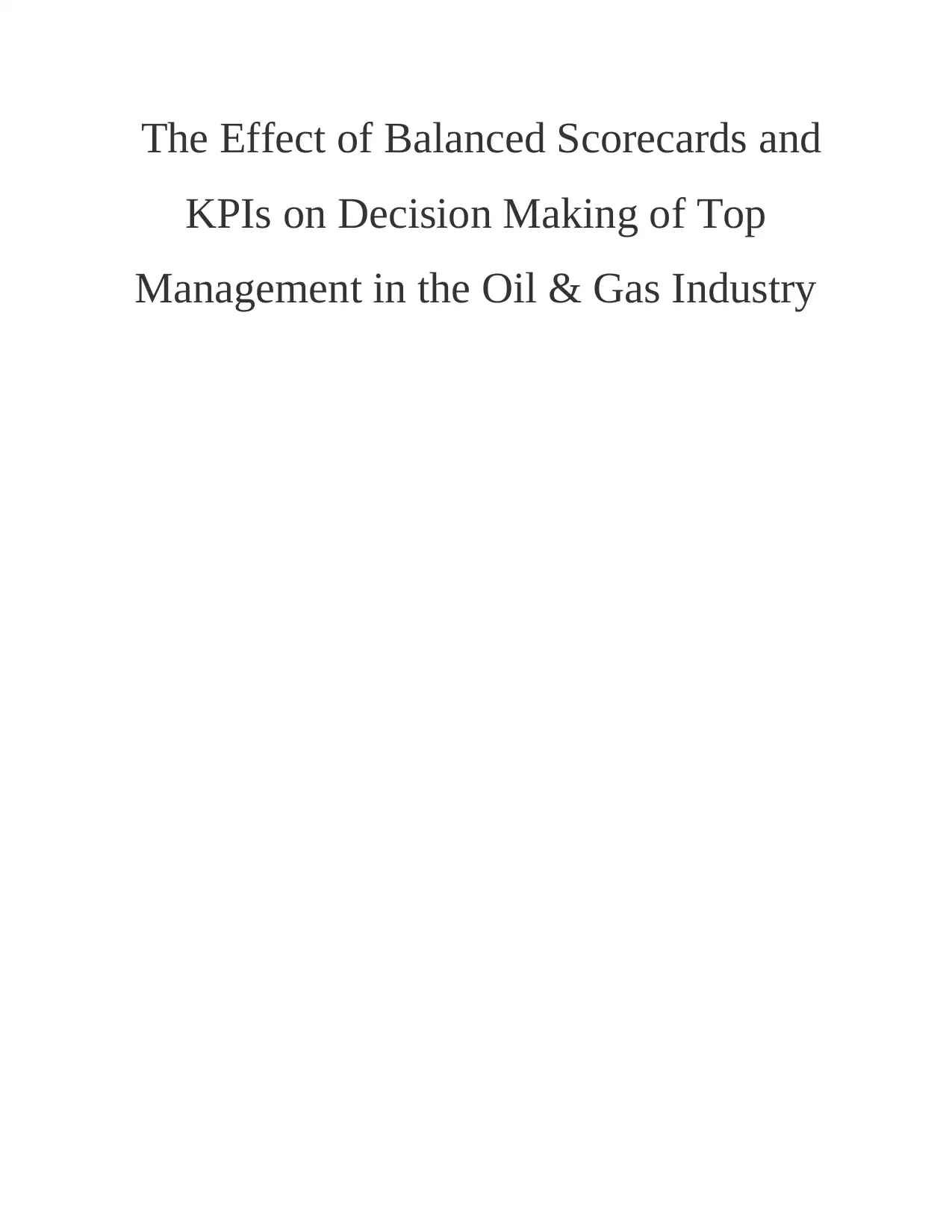
The Effect of Balanced Scorecards and
KPIs on Decision Making of Top
Management in the Oil & Gas Industry
KPIs on Decision Making of Top
Management in the Oil & Gas Industry
Paraphrase This Document
Need a fresh take? Get an instant paraphrase of this document with our AI Paraphraser
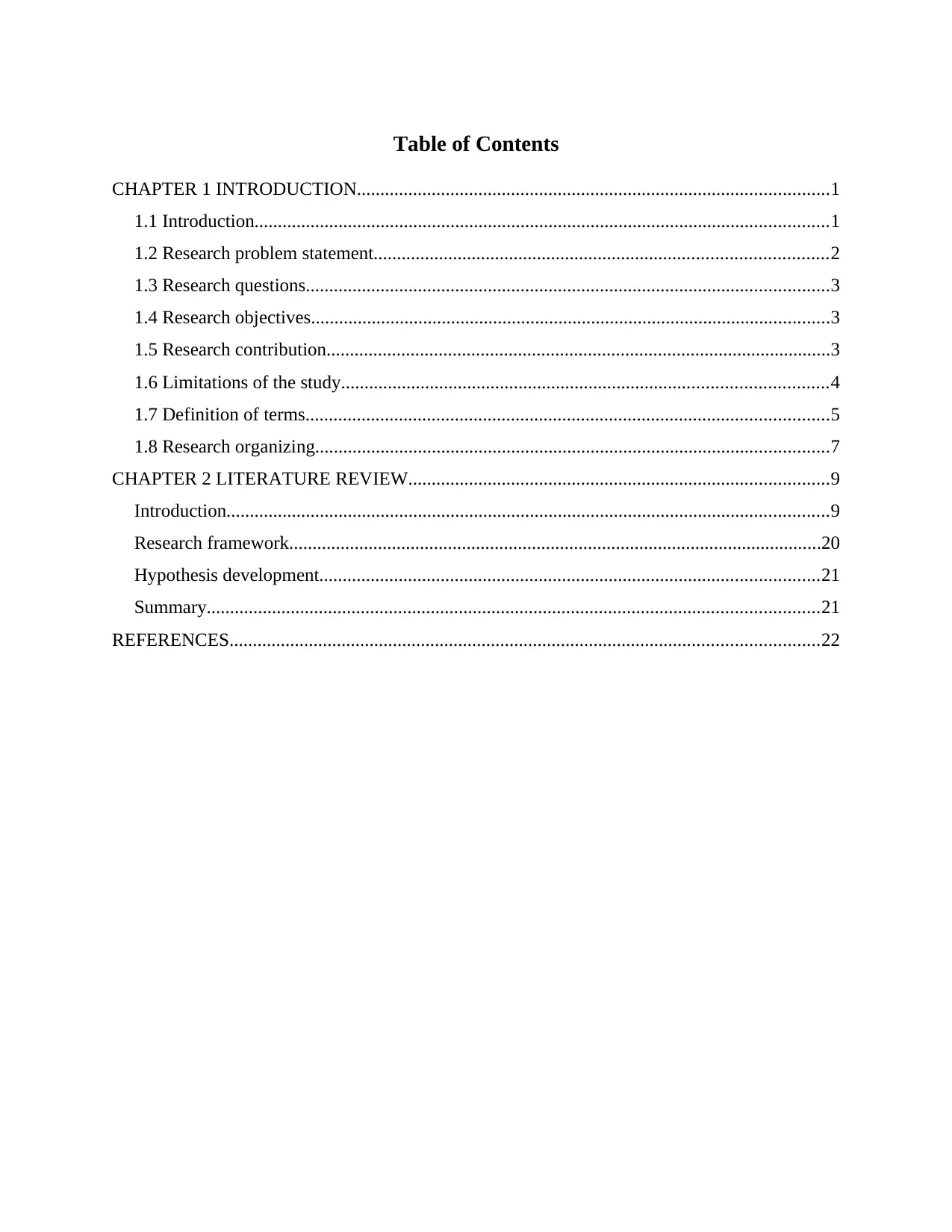
Table of Contents
CHAPTER 1 INTRODUCTION.....................................................................................................1
1.1 Introduction...........................................................................................................................1
1.2 Research problem statement.................................................................................................2
1.3 Research questions................................................................................................................3
1.4 Research objectives...............................................................................................................3
1.5 Research contribution............................................................................................................3
1.6 Limitations of the study........................................................................................................4
1.7 Definition of terms................................................................................................................5
1.8 Research organizing..............................................................................................................7
CHAPTER 2 LITERATURE REVIEW..........................................................................................9
Introduction.................................................................................................................................9
Research framework..................................................................................................................20
Hypothesis development...........................................................................................................21
Summary...................................................................................................................................21
REFERENCES..............................................................................................................................22
CHAPTER 1 INTRODUCTION.....................................................................................................1
1.1 Introduction...........................................................................................................................1
1.2 Research problem statement.................................................................................................2
1.3 Research questions................................................................................................................3
1.4 Research objectives...............................................................................................................3
1.5 Research contribution............................................................................................................3
1.6 Limitations of the study........................................................................................................4
1.7 Definition of terms................................................................................................................5
1.8 Research organizing..............................................................................................................7
CHAPTER 2 LITERATURE REVIEW..........................................................................................9
Introduction.................................................................................................................................9
Research framework..................................................................................................................20
Hypothesis development...........................................................................................................21
Summary...................................................................................................................................21
REFERENCES..............................................................................................................................22

Illustration Index
Illustration 1: Balance Scorecard...................................................................................................13
Illustration 1: Balance Scorecard...................................................................................................13
⊘ This is a preview!⊘
Do you want full access?
Subscribe today to unlock all pages.

Trusted by 1+ million students worldwide

CHAPTER 1 INTRODUCTION
1.1 Introduction
In each and every business enterprise, employees are considered as the firm's most
valuable asset as well as its biggest expense. It means that firm's productivity and profitability
depends upon ensuring that the worker's performance needs to exceed to their full potential.
Hence, in regard to survive and prosper in current economic times, businesses can no longer
manage using financial methods alone. Moreover, firm should focus upon improving non-
financial measures such as product quality, customer satisfaction and brand preference in order
to attain desired objectives (Wu, 2012). In regard to manage company's performance it then uses
Key Performance Indicators in order to analyse the track performance and base key strategic
decisions regarding managing people and resources. Using balance scorecards is beneficial
method in order to attain sustainable development of the firm and thus it will lead business to the
level of success. Thus, top management of oil and gas industry focuses upon undertaking balance
scorecards and KPI's which helps them to make effective decision making so that number of
operational activities can be managed in an effective way. Such methods are considered as one of
the best way to enhance the work performance and overcome problems (Barnabè, 2011).
It helps in facilitating top management in order to track execution of activities in
significant way so that objectives can be accomplished in an effective way. KPI and Balance
Scorecard are considered as best factors which helps in bringing effective sustainable
development to develop and implement strategic decision within oil and gas industry. Top
management within firm requires to effectively control and monitor the process so that proper
analysing number of factors play a crucial role in sustainable development. Key Performance
Indicators also helps in improving performance measurement so that top management within oil
and gas industry can make effective decisions regarding business success (Grigoroudis,
Orfanoudaki and Zopounidis, 2012).
It can be stated that through such performance measurement methods i.e. Balance
Scorecard and KPI it helps top management of oil and gas sector to effectively measure the
1
1.1 Introduction
In each and every business enterprise, employees are considered as the firm's most
valuable asset as well as its biggest expense. It means that firm's productivity and profitability
depends upon ensuring that the worker's performance needs to exceed to their full potential.
Hence, in regard to survive and prosper in current economic times, businesses can no longer
manage using financial methods alone. Moreover, firm should focus upon improving non-
financial measures such as product quality, customer satisfaction and brand preference in order
to attain desired objectives (Wu, 2012). In regard to manage company's performance it then uses
Key Performance Indicators in order to analyse the track performance and base key strategic
decisions regarding managing people and resources. Using balance scorecards is beneficial
method in order to attain sustainable development of the firm and thus it will lead business to the
level of success. Thus, top management of oil and gas industry focuses upon undertaking balance
scorecards and KPI's which helps them to make effective decision making so that number of
operational activities can be managed in an effective way. Such methods are considered as one of
the best way to enhance the work performance and overcome problems (Barnabè, 2011).
It helps in facilitating top management in order to track execution of activities in
significant way so that objectives can be accomplished in an effective way. KPI and Balance
Scorecard are considered as best factors which helps in bringing effective sustainable
development to develop and implement strategic decision within oil and gas industry. Top
management within firm requires to effectively control and monitor the process so that proper
analysing number of factors play a crucial role in sustainable development. Key Performance
Indicators also helps in improving performance measurement so that top management within oil
and gas industry can make effective decisions regarding business success (Grigoroudis,
Orfanoudaki and Zopounidis, 2012).
It can be stated that through such performance measurement methods i.e. Balance
Scorecard and KPI it helps top management of oil and gas sector to effectively measure the
1
Paraphrase This Document
Need a fresh take? Get an instant paraphrase of this document with our AI Paraphraser
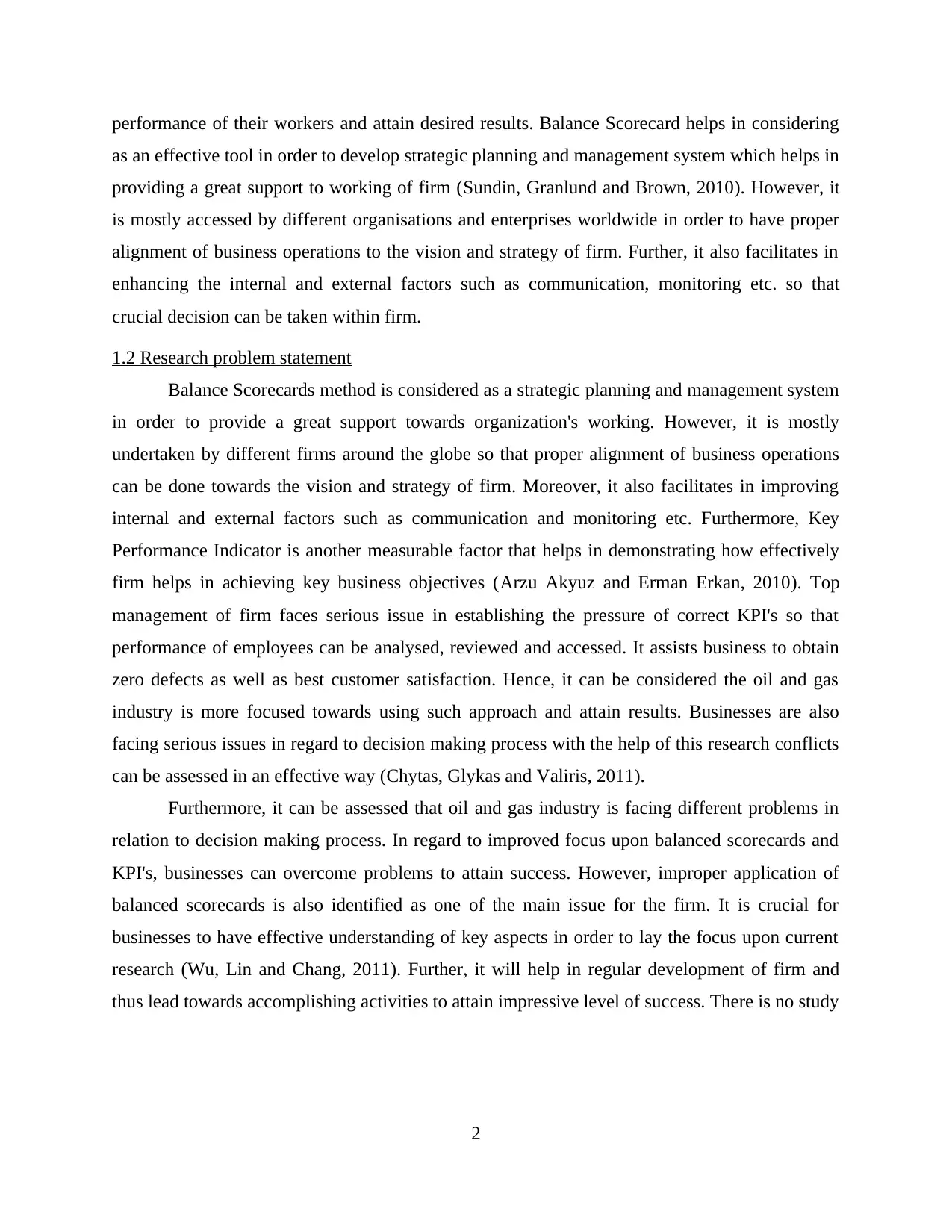
performance of their workers and attain desired results. Balance Scorecard helps in considering
as an effective tool in order to develop strategic planning and management system which helps in
providing a great support to working of firm (Sundin, Granlund and Brown, 2010). However, it
is mostly accessed by different organisations and enterprises worldwide in order to have proper
alignment of business operations to the vision and strategy of firm. Further, it also facilitates in
enhancing the internal and external factors such as communication, monitoring etc. so that
crucial decision can be taken within firm.
1.2 Research problem statement
Balance Scorecards method is considered as a strategic planning and management system
in order to provide a great support towards organization's working. However, it is mostly
undertaken by different firms around the globe so that proper alignment of business operations
can be done towards the vision and strategy of firm. Moreover, it also facilitates in improving
internal and external factors such as communication and monitoring etc. Furthermore, Key
Performance Indicator is another measurable factor that helps in demonstrating how effectively
firm helps in achieving key business objectives (Arzu Akyuz and Erman Erkan, 2010). Top
management of firm faces serious issue in establishing the pressure of correct KPI's so that
performance of employees can be analysed, reviewed and accessed. It assists business to obtain
zero defects as well as best customer satisfaction. Hence, it can be considered the oil and gas
industry is more focused towards using such approach and attain results. Businesses are also
facing serious issues in regard to decision making process with the help of this research conflicts
can be assessed in an effective way (Chytas, Glykas and Valiris, 2011).
Furthermore, it can be assessed that oil and gas industry is facing different problems in
relation to decision making process. In regard to improved focus upon balanced scorecards and
KPI's, businesses can overcome problems to attain success. However, improper application of
balanced scorecards is also identified as one of the main issue for the firm. It is crucial for
businesses to have effective understanding of key aspects in order to lay the focus upon current
research (Wu, Lin and Chang, 2011). Further, it will help in regular development of firm and
thus lead towards accomplishing activities to attain impressive level of success. There is no study
2
as an effective tool in order to develop strategic planning and management system which helps in
providing a great support to working of firm (Sundin, Granlund and Brown, 2010). However, it
is mostly accessed by different organisations and enterprises worldwide in order to have proper
alignment of business operations to the vision and strategy of firm. Further, it also facilitates in
enhancing the internal and external factors such as communication, monitoring etc. so that
crucial decision can be taken within firm.
1.2 Research problem statement
Balance Scorecards method is considered as a strategic planning and management system
in order to provide a great support towards organization's working. However, it is mostly
undertaken by different firms around the globe so that proper alignment of business operations
can be done towards the vision and strategy of firm. Moreover, it also facilitates in improving
internal and external factors such as communication and monitoring etc. Furthermore, Key
Performance Indicator is another measurable factor that helps in demonstrating how effectively
firm helps in achieving key business objectives (Arzu Akyuz and Erman Erkan, 2010). Top
management of firm faces serious issue in establishing the pressure of correct KPI's so that
performance of employees can be analysed, reviewed and accessed. It assists business to obtain
zero defects as well as best customer satisfaction. Hence, it can be considered the oil and gas
industry is more focused towards using such approach and attain results. Businesses are also
facing serious issues in regard to decision making process with the help of this research conflicts
can be assessed in an effective way (Chytas, Glykas and Valiris, 2011).
Furthermore, it can be assessed that oil and gas industry is facing different problems in
relation to decision making process. In regard to improved focus upon balanced scorecards and
KPI's, businesses can overcome problems to attain success. However, improper application of
balanced scorecards is also identified as one of the main issue for the firm. It is crucial for
businesses to have effective understanding of key aspects in order to lay the focus upon current
research (Wu, Lin and Chang, 2011). Further, it will help in regular development of firm and
thus lead towards accomplishing activities to attain impressive level of success. There is no study
2

being made in such field and also workers are not satisfied with the end results from the decision
making process of top management.
1.3 Research questions
What is the role of balance scorecards in decision making process of oil and gas industry?
How KPI's impact upon the effectiveness of decisions?
What are the way in which oil and gas sector can utilize both balance scorecards and
KPI's for effective accomplishment of decision making process?
1.4 Research objectives
Main aim of the research to investigate “The effect of Balance Scorecards and KPI's on
decision makers of Top Management in Oil and Gas Industry”. Here, in regard to better
understand regarding the subject matter Oil and Gas sector has been selected. It will help in
exposing the effect, impact of Balance Scorecards upon strategic decision making.
Objectives-
To determine the role of balance scorecards in decision making process of oil and gas
industry.
To assess the impact of KPI's on effectiveness of decisions.
To recommend ways through which oil and gas sector can utilize balance scorecards and
KPI's for effective accomplishment of decision making process.
1.5 Research contribution
It can be assessed that through carrying out the present study it focuses upon identifying
the effects of benchmarking and KPI's so that it helps top management to enhance the
performance of employees and make crucial decision to attain success. Also, the quality and
significance of research will highly depend upon the contribution that research will help in
adding it as a value (Northcott and Ma'amora Taulapapa, 2012). Further, researcher aims to
develop theory and practice in this field as well as policy development so that success can be
attained. Scholar aims to justify the work through contributing something to theory building and
practice it within the field as well as policy development in the particular area. However, a
3
making process of top management.
1.3 Research questions
What is the role of balance scorecards in decision making process of oil and gas industry?
How KPI's impact upon the effectiveness of decisions?
What are the way in which oil and gas sector can utilize both balance scorecards and
KPI's for effective accomplishment of decision making process?
1.4 Research objectives
Main aim of the research to investigate “The effect of Balance Scorecards and KPI's on
decision makers of Top Management in Oil and Gas Industry”. Here, in regard to better
understand regarding the subject matter Oil and Gas sector has been selected. It will help in
exposing the effect, impact of Balance Scorecards upon strategic decision making.
Objectives-
To determine the role of balance scorecards in decision making process of oil and gas
industry.
To assess the impact of KPI's on effectiveness of decisions.
To recommend ways through which oil and gas sector can utilize balance scorecards and
KPI's for effective accomplishment of decision making process.
1.5 Research contribution
It can be assessed that through carrying out the present study it focuses upon identifying
the effects of benchmarking and KPI's so that it helps top management to enhance the
performance of employees and make crucial decision to attain success. Also, the quality and
significance of research will highly depend upon the contribution that research will help in
adding it as a value (Northcott and Ma'amora Taulapapa, 2012). Further, researcher aims to
develop theory and practice in this field as well as policy development so that success can be
attained. Scholar aims to justify the work through contributing something to theory building and
practice it within the field as well as policy development in the particular area. However, a
3
⊘ This is a preview!⊘
Do you want full access?
Subscribe today to unlock all pages.

Trusted by 1+ million students worldwide
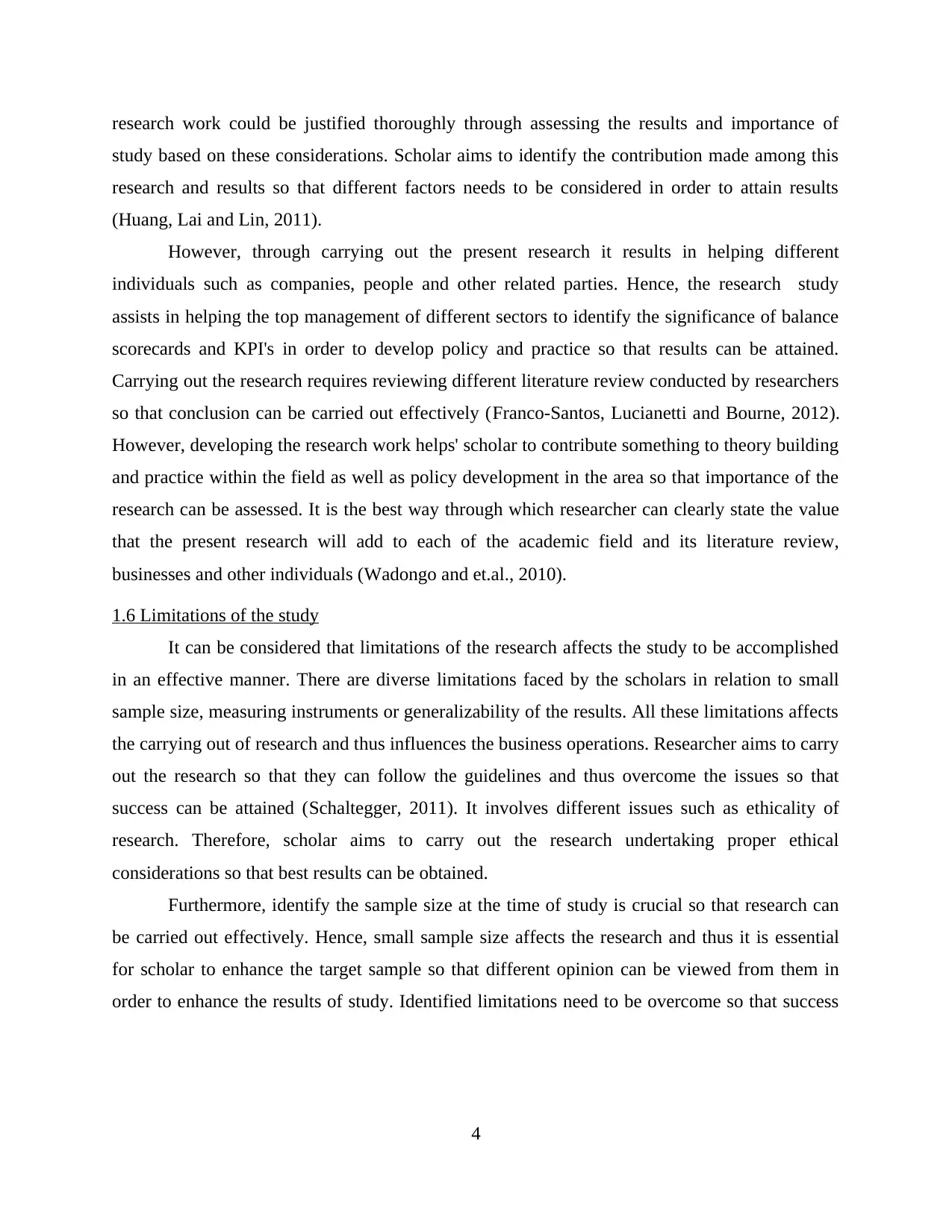
research work could be justified thoroughly through assessing the results and importance of
study based on these considerations. Scholar aims to identify the contribution made among this
research and results so that different factors needs to be considered in order to attain results
(Huang, Lai and Lin, 2011).
However, through carrying out the present research it results in helping different
individuals such as companies, people and other related parties. Hence, the research study
assists in helping the top management of different sectors to identify the significance of balance
scorecards and KPI's in order to develop policy and practice so that results can be attained.
Carrying out the research requires reviewing different literature review conducted by researchers
so that conclusion can be carried out effectively (Franco-Santos, Lucianetti and Bourne, 2012).
However, developing the research work helps' scholar to contribute something to theory building
and practice within the field as well as policy development in the area so that importance of the
research can be assessed. It is the best way through which researcher can clearly state the value
that the present research will add to each of the academic field and its literature review,
businesses and other individuals (Wadongo and et.al., 2010).
1.6 Limitations of the study
It can be considered that limitations of the research affects the study to be accomplished
in an effective manner. There are diverse limitations faced by the scholars in relation to small
sample size, measuring instruments or generalizability of the results. All these limitations affects
the carrying out of research and thus influences the business operations. Researcher aims to carry
out the research so that they can follow the guidelines and thus overcome the issues so that
success can be attained (Schaltegger, 2011). It involves different issues such as ethicality of
research. Therefore, scholar aims to carry out the research undertaking proper ethical
considerations so that best results can be obtained.
Furthermore, identify the sample size at the time of study is crucial so that research can
be carried out effectively. Hence, small sample size affects the research and thus it is essential
for scholar to enhance the target sample so that different opinion can be viewed from them in
order to enhance the results of study. Identified limitations need to be overcome so that success
4
study based on these considerations. Scholar aims to identify the contribution made among this
research and results so that different factors needs to be considered in order to attain results
(Huang, Lai and Lin, 2011).
However, through carrying out the present research it results in helping different
individuals such as companies, people and other related parties. Hence, the research study
assists in helping the top management of different sectors to identify the significance of balance
scorecards and KPI's in order to develop policy and practice so that results can be attained.
Carrying out the research requires reviewing different literature review conducted by researchers
so that conclusion can be carried out effectively (Franco-Santos, Lucianetti and Bourne, 2012).
However, developing the research work helps' scholar to contribute something to theory building
and practice within the field as well as policy development in the area so that importance of the
research can be assessed. It is the best way through which researcher can clearly state the value
that the present research will add to each of the academic field and its literature review,
businesses and other individuals (Wadongo and et.al., 2010).
1.6 Limitations of the study
It can be considered that limitations of the research affects the study to be accomplished
in an effective manner. There are diverse limitations faced by the scholars in relation to small
sample size, measuring instruments or generalizability of the results. All these limitations affects
the carrying out of research and thus influences the business operations. Researcher aims to carry
out the research so that they can follow the guidelines and thus overcome the issues so that
success can be attained (Schaltegger, 2011). It involves different issues such as ethicality of
research. Therefore, scholar aims to carry out the research undertaking proper ethical
considerations so that best results can be obtained.
Furthermore, identify the sample size at the time of study is crucial so that research can
be carried out effectively. Hence, small sample size affects the research and thus it is essential
for scholar to enhance the target sample so that different opinion can be viewed from them in
order to enhance the results of study. Identified limitations need to be overcome so that success
4
Paraphrase This Document
Need a fresh take? Get an instant paraphrase of this document with our AI Paraphraser
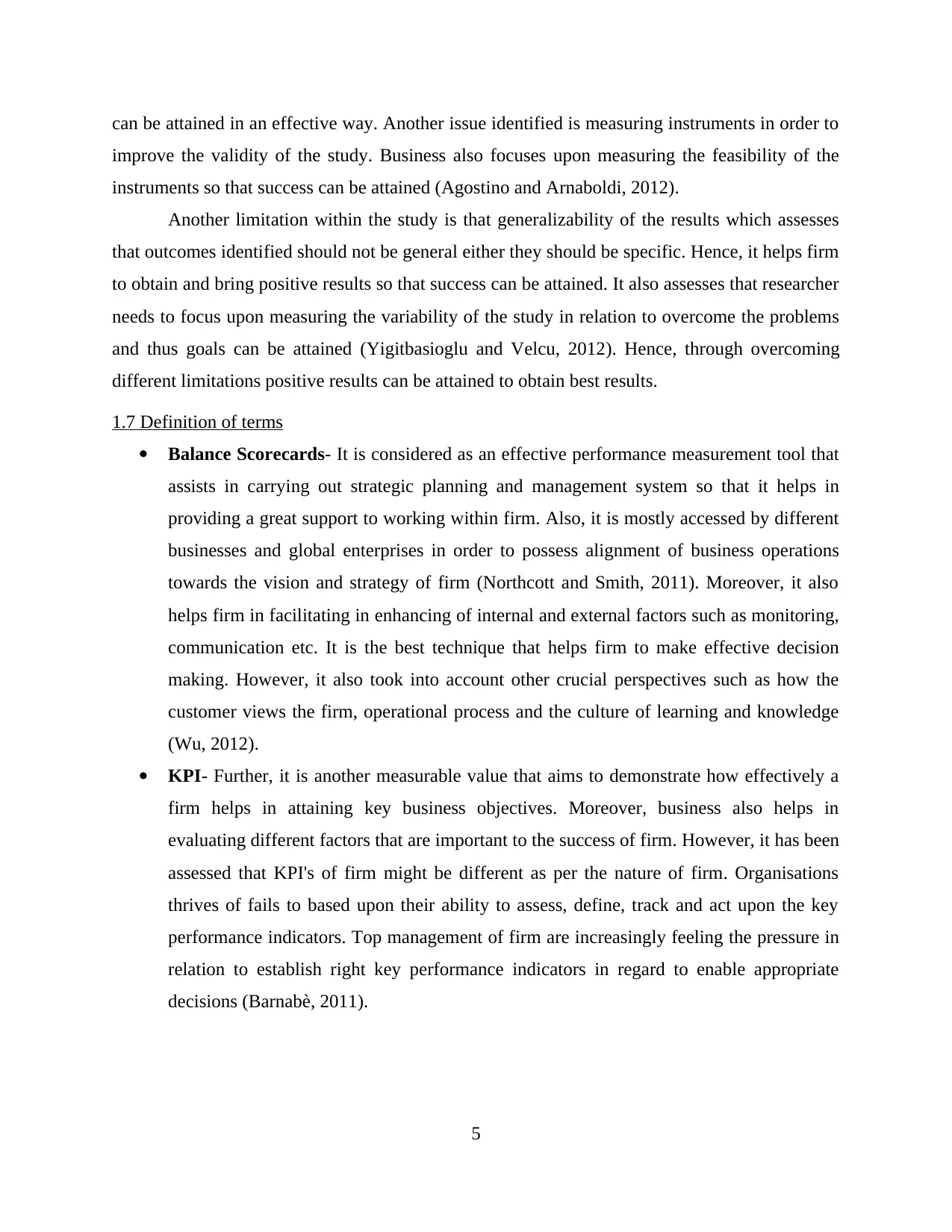
can be attained in an effective way. Another issue identified is measuring instruments in order to
improve the validity of the study. Business also focuses upon measuring the feasibility of the
instruments so that success can be attained (Agostino and Arnaboldi, 2012).
Another limitation within the study is that generalizability of the results which assesses
that outcomes identified should not be general either they should be specific. Hence, it helps firm
to obtain and bring positive results so that success can be attained. It also assesses that researcher
needs to focus upon measuring the variability of the study in relation to overcome the problems
and thus goals can be attained (Yigitbasioglu and Velcu, 2012). Hence, through overcoming
different limitations positive results can be attained to obtain best results.
1.7 Definition of terms
Balance Scorecards- It is considered as an effective performance measurement tool that
assists in carrying out strategic planning and management system so that it helps in
providing a great support to working within firm. Also, it is mostly accessed by different
businesses and global enterprises in order to possess alignment of business operations
towards the vision and strategy of firm (Northcott and Smith, 2011). Moreover, it also
helps firm in facilitating in enhancing of internal and external factors such as monitoring,
communication etc. It is the best technique that helps firm to make effective decision
making. However, it also took into account other crucial perspectives such as how the
customer views the firm, operational process and the culture of learning and knowledge
(Wu, 2012).
KPI- Further, it is another measurable value that aims to demonstrate how effectively a
firm helps in attaining key business objectives. Moreover, business also helps in
evaluating different factors that are important to the success of firm. However, it has been
assessed that KPI's of firm might be different as per the nature of firm. Organisations
thrives of fails to based upon their ability to assess, define, track and act upon the key
performance indicators. Top management of firm are increasingly feeling the pressure in
relation to establish right key performance indicators in regard to enable appropriate
decisions (Barnabè, 2011).
5
improve the validity of the study. Business also focuses upon measuring the feasibility of the
instruments so that success can be attained (Agostino and Arnaboldi, 2012).
Another limitation within the study is that generalizability of the results which assesses
that outcomes identified should not be general either they should be specific. Hence, it helps firm
to obtain and bring positive results so that success can be attained. It also assesses that researcher
needs to focus upon measuring the variability of the study in relation to overcome the problems
and thus goals can be attained (Yigitbasioglu and Velcu, 2012). Hence, through overcoming
different limitations positive results can be attained to obtain best results.
1.7 Definition of terms
Balance Scorecards- It is considered as an effective performance measurement tool that
assists in carrying out strategic planning and management system so that it helps in
providing a great support to working within firm. Also, it is mostly accessed by different
businesses and global enterprises in order to possess alignment of business operations
towards the vision and strategy of firm (Northcott and Smith, 2011). Moreover, it also
helps firm in facilitating in enhancing of internal and external factors such as monitoring,
communication etc. It is the best technique that helps firm to make effective decision
making. However, it also took into account other crucial perspectives such as how the
customer views the firm, operational process and the culture of learning and knowledge
(Wu, 2012).
KPI- Further, it is another measurable value that aims to demonstrate how effectively a
firm helps in attaining key business objectives. Moreover, business also helps in
evaluating different factors that are important to the success of firm. However, it has been
assessed that KPI's of firm might be different as per the nature of firm. Organisations
thrives of fails to based upon their ability to assess, define, track and act upon the key
performance indicators. Top management of firm are increasingly feeling the pressure in
relation to establish right key performance indicators in regard to enable appropriate
decisions (Barnabè, 2011).
5
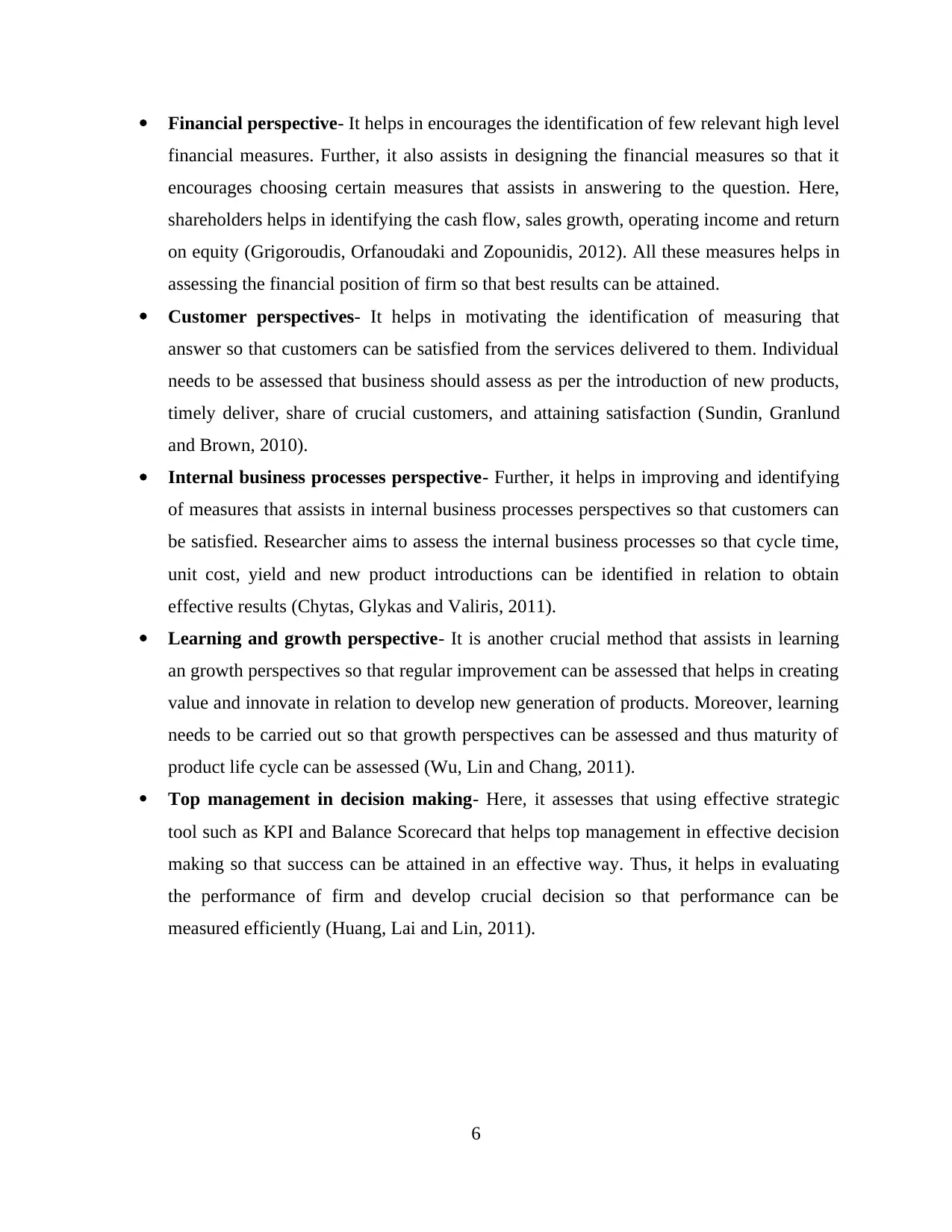
Financial perspective- It helps in encourages the identification of few relevant high level
financial measures. Further, it also assists in designing the financial measures so that it
encourages choosing certain measures that assists in answering to the question. Here,
shareholders helps in identifying the cash flow, sales growth, operating income and return
on equity (Grigoroudis, Orfanoudaki and Zopounidis, 2012). All these measures helps in
assessing the financial position of firm so that best results can be attained.
Customer perspectives- It helps in motivating the identification of measuring that
answer so that customers can be satisfied from the services delivered to them. Individual
needs to be assessed that business should assess as per the introduction of new products,
timely deliver, share of crucial customers, and attaining satisfaction (Sundin, Granlund
and Brown, 2010).
Internal business processes perspective- Further, it helps in improving and identifying
of measures that assists in internal business processes perspectives so that customers can
be satisfied. Researcher aims to assess the internal business processes so that cycle time,
unit cost, yield and new product introductions can be identified in relation to obtain
effective results (Chytas, Glykas and Valiris, 2011).
Learning and growth perspective- It is another crucial method that assists in learning
an growth perspectives so that regular improvement can be assessed that helps in creating
value and innovate in relation to develop new generation of products. Moreover, learning
needs to be carried out so that growth perspectives can be assessed and thus maturity of
product life cycle can be assessed (Wu, Lin and Chang, 2011).
Top management in decision making- Here, it assesses that using effective strategic
tool such as KPI and Balance Scorecard that helps top management in effective decision
making so that success can be attained in an effective way. Thus, it helps in evaluating
the performance of firm and develop crucial decision so that performance can be
measured efficiently (Huang, Lai and Lin, 2011).
6
financial measures. Further, it also assists in designing the financial measures so that it
encourages choosing certain measures that assists in answering to the question. Here,
shareholders helps in identifying the cash flow, sales growth, operating income and return
on equity (Grigoroudis, Orfanoudaki and Zopounidis, 2012). All these measures helps in
assessing the financial position of firm so that best results can be attained.
Customer perspectives- It helps in motivating the identification of measuring that
answer so that customers can be satisfied from the services delivered to them. Individual
needs to be assessed that business should assess as per the introduction of new products,
timely deliver, share of crucial customers, and attaining satisfaction (Sundin, Granlund
and Brown, 2010).
Internal business processes perspective- Further, it helps in improving and identifying
of measures that assists in internal business processes perspectives so that customers can
be satisfied. Researcher aims to assess the internal business processes so that cycle time,
unit cost, yield and new product introductions can be identified in relation to obtain
effective results (Chytas, Glykas and Valiris, 2011).
Learning and growth perspective- It is another crucial method that assists in learning
an growth perspectives so that regular improvement can be assessed that helps in creating
value and innovate in relation to develop new generation of products. Moreover, learning
needs to be carried out so that growth perspectives can be assessed and thus maturity of
product life cycle can be assessed (Wu, Lin and Chang, 2011).
Top management in decision making- Here, it assesses that using effective strategic
tool such as KPI and Balance Scorecard that helps top management in effective decision
making so that success can be attained in an effective way. Thus, it helps in evaluating
the performance of firm and develop crucial decision so that performance can be
measured efficiently (Huang, Lai and Lin, 2011).
6
⊘ This is a preview!⊘
Do you want full access?
Subscribe today to unlock all pages.

Trusted by 1+ million students worldwide

1.8 Research organizing
Here, it can be assessed that in the first chapter researcher identifies the introduction
chapter that consists of background of the research, aims and objectives, research questions,
problem statement, contribution of the research, limitations of the study, defining different
variables involved within the study and research organizing etc. All these parts are involved in
the introduction chapter and thus it helps in conducting the study through introducing the issues
and current state of knowledge in terms of conceptual, theoretical development and research in
the area. Study also assists in identifying the research gaps so that chapter can be concluded
efficiently (Franco-Santos, Lucianetti and Bourne, 2012). In the introduction part it assists
researcher to introduces major variables of the study and thus relate them to the previous
research and theory. Hence, through this it helps scholar to look at different studies or articles
published as currently as possible so that whatever is discussed or reviewed is not something out
of date or even irrelevant. Further, using major variable involved within the study helps in
indicating the fact in order to make individual aware about the problem identified in the research.
Also, in the first chapter background is discussed that highlights the current state of knowledge
and possible gaps in the area. Moreover, applying research studies helps in identifying the
background section that helps in discussing and highlighting the management problems or
business situations and thus success can be attained (Wadongo and et.al., 2010).
Further, another chapter carried out within the research is literature review in which
different previous studies has been carried out upon dependent as well as independent variables.
It also studying of different researches related to the topic so that research development can be
attained (Schaltegger, 2011). This part helps in reviewing and developing hypothesis so that
proper variables has been used to carry out the study and thus information has been provided for
further readers. Here, critically reviewing the published work in the area of study that the student
is undertaking so that theoretical development in order to enhance the significance of study.
Moreover, result of the review needs to showcase the current state of knowledge in the
area in terms of carrying out in-depth research. It also assesses that strengths and weaknesses of
previous research and thus evaluate the knowledge gap that needs further explanation of the
7
Here, it can be assessed that in the first chapter researcher identifies the introduction
chapter that consists of background of the research, aims and objectives, research questions,
problem statement, contribution of the research, limitations of the study, defining different
variables involved within the study and research organizing etc. All these parts are involved in
the introduction chapter and thus it helps in conducting the study through introducing the issues
and current state of knowledge in terms of conceptual, theoretical development and research in
the area. Study also assists in identifying the research gaps so that chapter can be concluded
efficiently (Franco-Santos, Lucianetti and Bourne, 2012). In the introduction part it assists
researcher to introduces major variables of the study and thus relate them to the previous
research and theory. Hence, through this it helps scholar to look at different studies or articles
published as currently as possible so that whatever is discussed or reviewed is not something out
of date or even irrelevant. Further, using major variable involved within the study helps in
indicating the fact in order to make individual aware about the problem identified in the research.
Also, in the first chapter background is discussed that highlights the current state of knowledge
and possible gaps in the area. Moreover, applying research studies helps in identifying the
background section that helps in discussing and highlighting the management problems or
business situations and thus success can be attained (Wadongo and et.al., 2010).
Further, another chapter carried out within the research is literature review in which
different previous studies has been carried out upon dependent as well as independent variables.
It also studying of different researches related to the topic so that research development can be
attained (Schaltegger, 2011). This part helps in reviewing and developing hypothesis so that
proper variables has been used to carry out the study and thus information has been provided for
further readers. Here, critically reviewing the published work in the area of study that the student
is undertaking so that theoretical development in order to enhance the significance of study.
Moreover, result of the review needs to showcase the current state of knowledge in the
area in terms of carrying out in-depth research. It also assesses that strengths and weaknesses of
previous research and thus evaluate the knowledge gap that needs further explanation of the
7
Paraphrase This Document
Need a fresh take? Get an instant paraphrase of this document with our AI Paraphraser
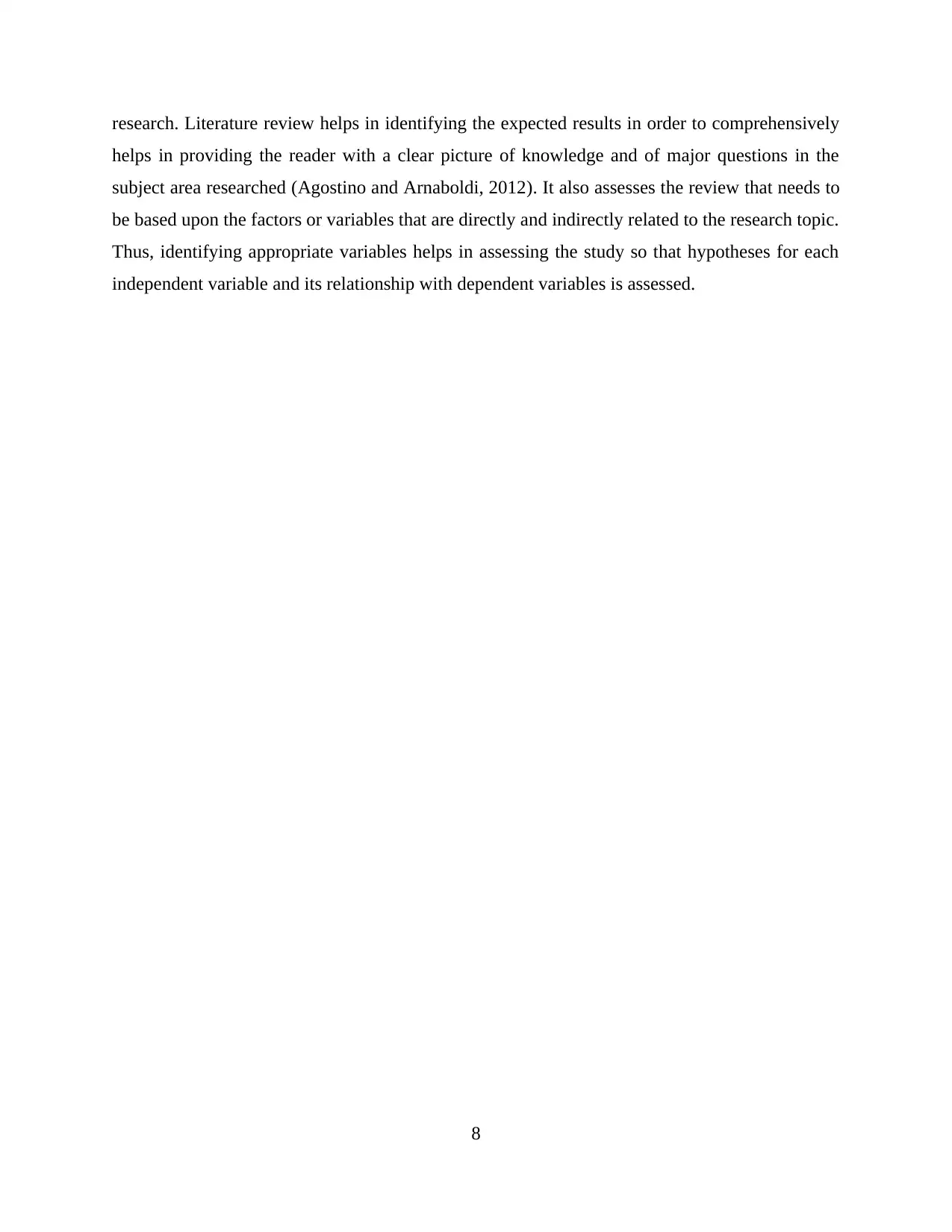
research. Literature review helps in identifying the expected results in order to comprehensively
helps in providing the reader with a clear picture of knowledge and of major questions in the
subject area researched (Agostino and Arnaboldi, 2012). It also assesses the review that needs to
be based upon the factors or variables that are directly and indirectly related to the research topic.
Thus, identifying appropriate variables helps in assessing the study so that hypotheses for each
independent variable and its relationship with dependent variables is assessed.
8
helps in providing the reader with a clear picture of knowledge and of major questions in the
subject area researched (Agostino and Arnaboldi, 2012). It also assesses the review that needs to
be based upon the factors or variables that are directly and indirectly related to the research topic.
Thus, identifying appropriate variables helps in assessing the study so that hypotheses for each
independent variable and its relationship with dependent variables is assessed.
8
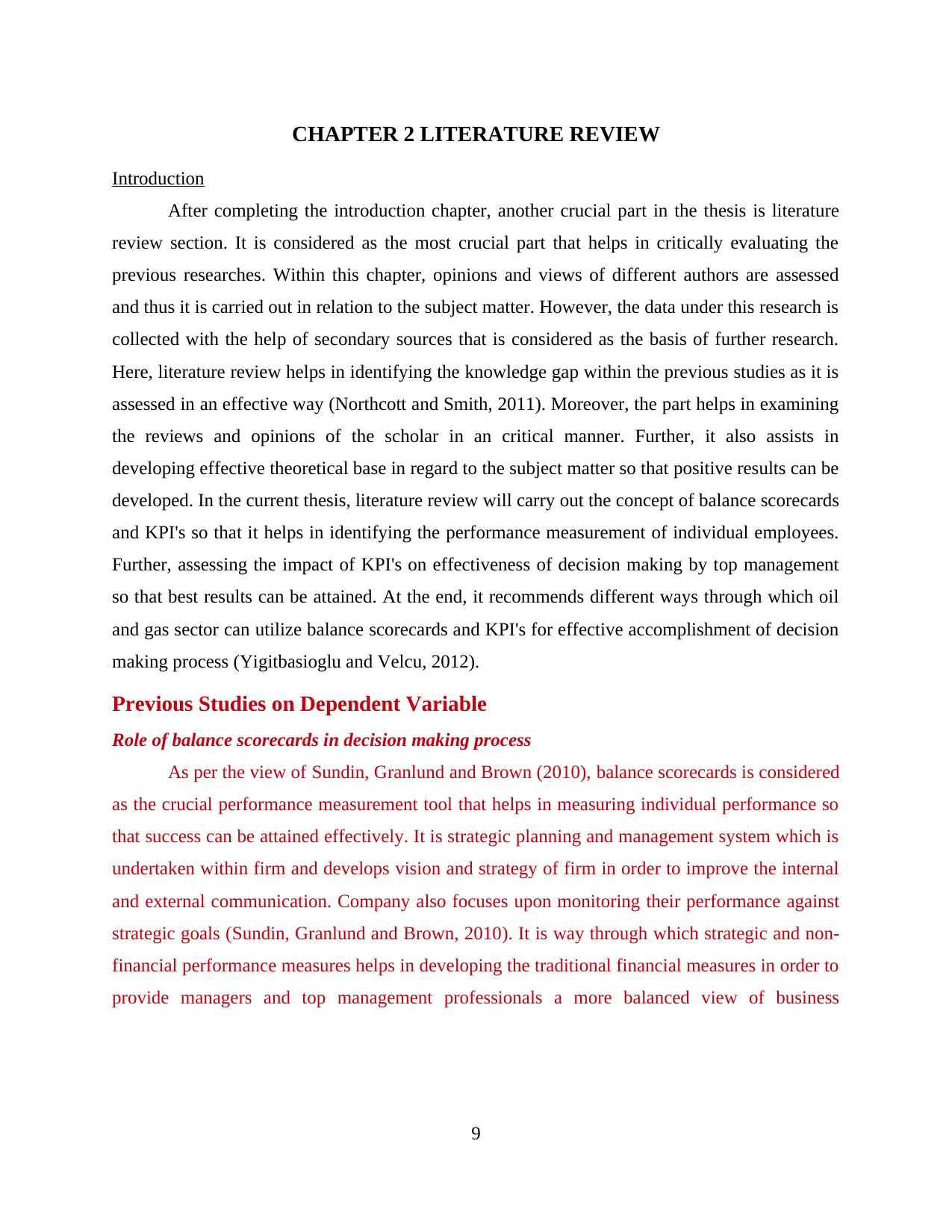
CHAPTER 2 LITERATURE REVIEW
Introduction
After completing the introduction chapter, another crucial part in the thesis is literature
review section. It is considered as the most crucial part that helps in critically evaluating the
previous researches. Within this chapter, opinions and views of different authors are assessed
and thus it is carried out in relation to the subject matter. However, the data under this research is
collected with the help of secondary sources that is considered as the basis of further research.
Here, literature review helps in identifying the knowledge gap within the previous studies as it is
assessed in an effective way (Northcott and Smith, 2011). Moreover, the part helps in examining
the reviews and opinions of the scholar in an critical manner. Further, it also assists in
developing effective theoretical base in regard to the subject matter so that positive results can be
developed. In the current thesis, literature review will carry out the concept of balance scorecards
and KPI's so that it helps in identifying the performance measurement of individual employees.
Further, assessing the impact of KPI's on effectiveness of decision making by top management
so that best results can be attained. At the end, it recommends different ways through which oil
and gas sector can utilize balance scorecards and KPI's for effective accomplishment of decision
making process (Yigitbasioglu and Velcu, 2012).
Previous Studies on Dependent Variable
Role of balance scorecards in decision making process
As per the view of Sundin, Granlund and Brown (2010), balance scorecards is considered
as the crucial performance measurement tool that helps in measuring individual performance so
that success can be attained effectively. It is strategic planning and management system which is
undertaken within firm and develops vision and strategy of firm in order to improve the internal
and external communication. Company also focuses upon monitoring their performance against
strategic goals (Sundin, Granlund and Brown, 2010). It is way through which strategic and non-
financial performance measures helps in developing the traditional financial measures in order to
provide managers and top management professionals a more balanced view of business
9
Introduction
After completing the introduction chapter, another crucial part in the thesis is literature
review section. It is considered as the most crucial part that helps in critically evaluating the
previous researches. Within this chapter, opinions and views of different authors are assessed
and thus it is carried out in relation to the subject matter. However, the data under this research is
collected with the help of secondary sources that is considered as the basis of further research.
Here, literature review helps in identifying the knowledge gap within the previous studies as it is
assessed in an effective way (Northcott and Smith, 2011). Moreover, the part helps in examining
the reviews and opinions of the scholar in an critical manner. Further, it also assists in
developing effective theoretical base in regard to the subject matter so that positive results can be
developed. In the current thesis, literature review will carry out the concept of balance scorecards
and KPI's so that it helps in identifying the performance measurement of individual employees.
Further, assessing the impact of KPI's on effectiveness of decision making by top management
so that best results can be attained. At the end, it recommends different ways through which oil
and gas sector can utilize balance scorecards and KPI's for effective accomplishment of decision
making process (Yigitbasioglu and Velcu, 2012).
Previous Studies on Dependent Variable
Role of balance scorecards in decision making process
As per the view of Sundin, Granlund and Brown (2010), balance scorecards is considered
as the crucial performance measurement tool that helps in measuring individual performance so
that success can be attained effectively. It is strategic planning and management system which is
undertaken within firm and develops vision and strategy of firm in order to improve the internal
and external communication. Company also focuses upon monitoring their performance against
strategic goals (Sundin, Granlund and Brown, 2010). It is way through which strategic and non-
financial performance measures helps in developing the traditional financial measures in order to
provide managers and top management professionals a more balanced view of business
9
⊘ This is a preview!⊘
Do you want full access?
Subscribe today to unlock all pages.

Trusted by 1+ million students worldwide
1 out of 30
Related Documents
Your All-in-One AI-Powered Toolkit for Academic Success.
+13062052269
info@desklib.com
Available 24*7 on WhatsApp / Email
![[object Object]](/_next/static/media/star-bottom.7253800d.svg)
Unlock your academic potential
Copyright © 2020–2025 A2Z Services. All Rights Reserved. Developed and managed by ZUCOL.





